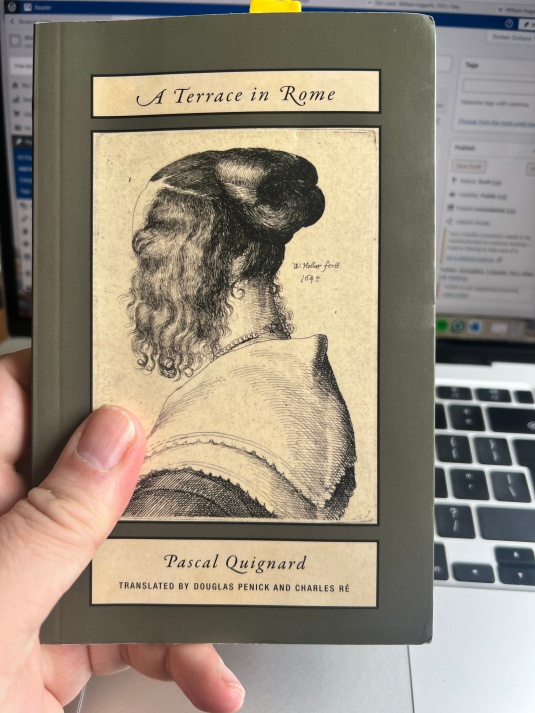A Terrace in Rome by Pascal Quingard
French fiction
Original title – Terrasse à Rome
Translator – Douglas Penick and Charle Ré
Source – Personal copy
We all have a list of writers we want to get to well. Pascal Quingard has been on my list of writers to read for a couple of years now . I’m not sure where I first heard about this book. It was probably Twitter somewhere. But the fragmented nature of this book, when I heard about it, appealed, and the fact it was about an engraver as we had some acid etch engravings at my father’s house. Quingard has won several prizes won the Prix Goncourt, which in many ways is like the French Booker or is it the other way around? The Goncourt has been going longer. He has written many books, and sadly, they seemed to have never quite been taken in English as a writer. I’m not sure if it is their style of writing or if his books are all different? This is my first but not my last I will say that.
A few days later, one morning in August 1639, a most beautiful day, Nanni wakes him up. Meaume doesn’t believe his eyes. She is there, in his garret. The girl he loves has returned. She is leaning over him. She is tapping his shoulder. He is naked. She does not lust after his naked-ness. On the contrary, she throws a shirt on his belly. She whispers in a low voice, an urgent voice: “Listen to me.
Listen to me.”
She turns around as if someone were following her.
Her face is that of a frightened woman. Her eyes sparkle with anguish. Her face is flushed, gentle, drawn, emaciat-ed, serious. She has dark circles under her eyes. Her long hair is tied back simply under her gray cap. She is wearing a gray dress with a white ruff. She is more beautiful than ever. She bends toward him.
She tells him to go or he may die
This is the life story of an engraver called Geoffrey Meaume. He is learning his trade in Bruge when he falls for the daughter of the goldsmith, her slim waist, hands, and heavy breasts. They meet and fall for one another, but she has a fiance. This is early on in the book, and when the fiance catches up with Meaume, he throws acid in the young man’s face, causing him to be disfigured for the rest of his life. This seems to be the end of it till the young woman appears and tells him that her fiance isn’t happy that he was fined for what he did to Meaume. But this has not simmered, and he now wants Meaume dead. So the young engraver goes on the run and ends up first in Mainz Germany. As he moves the engraving, he draws go from Erotic to religious A man scared for life pours his life into his art but also the memories and glances of women as he goes through his life is a sort of torment life in small chapters as this man has very little joy apart from that one time that ends in is face being burnt off by acid.
He runs, he ran. Left Mainz. He stayed three weeks on his own without putting his nose outside the door of an inn on the other bank of the Rhine where he had taken lodgings in a sort of stable with six other men. Three weeks of dry sobs, his body lying in the hay and its heavy smell. Then he left that world, crossed Wurtemberg, the Swiss cantons, the Alps, the Vatican States, Rome, Naples. He went to hide his face for two years, staying in Ravello above the little village, in a cliff on the Gulf of Salerno. Finally it was Rome in 1643, the Aventine Hill, the terrace with the covered porch, the nocturnal engravings, the scandalous collection of 165o, the erotic cards on which he dreamed of love. The engravings were marked with the sign of the shop, the Black Maltese Cross on the Via Giulia.
He eventually ends up in Rome hence the title .
This is a look at a torment soul a man that was young and brilliant at his art attractive to this young woman and all this end with the acid attack it is a survivor story but the torement from having such a scar and how his disfigured face will effect the rest of his life. As a man broken by that one event and how this can lead to a dark life of repressed desire , sex, and wanting in the man. I loved the fragmented nature of the books they are like etchings from his life a sort of literary version of Gin Lane. This is a tale of a man’s downfall in a way like the famous etching by Hogarth. It reminds you how etchings are the photo magazines of their day capturing events beauties like early in the book or scenes of religious imagery. I have found a writer I want to read lots more from Qingard. It is always a joy to discover a writer with a style I like the fragmented nature of this book as we look at the vignettes of this guy’s life like a pile of old Polaroids telling a story over time in the changes we don’t see at first but in photos and here in the vignettes, we see how his life move on. WHat is your favourite book by this writer?
Winston’s score – A , A new voice for this reviewer to read .

